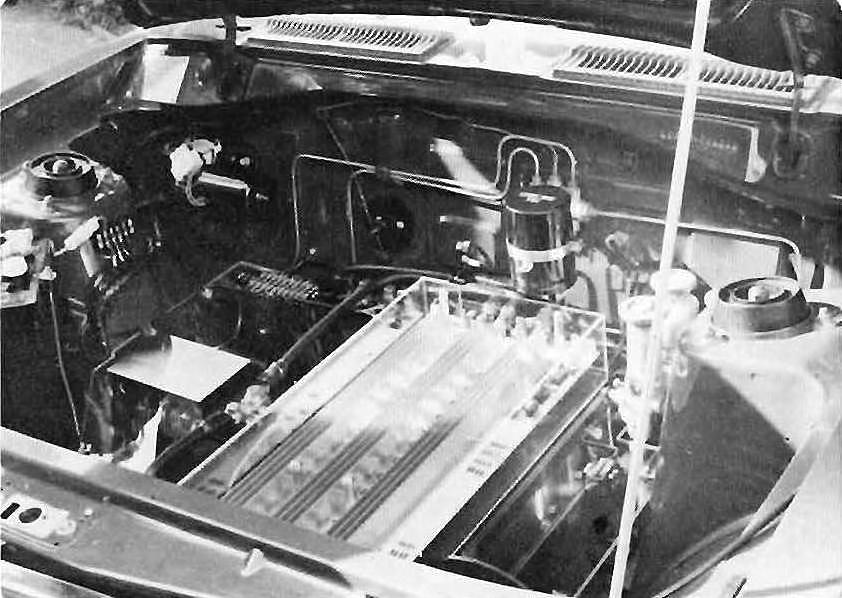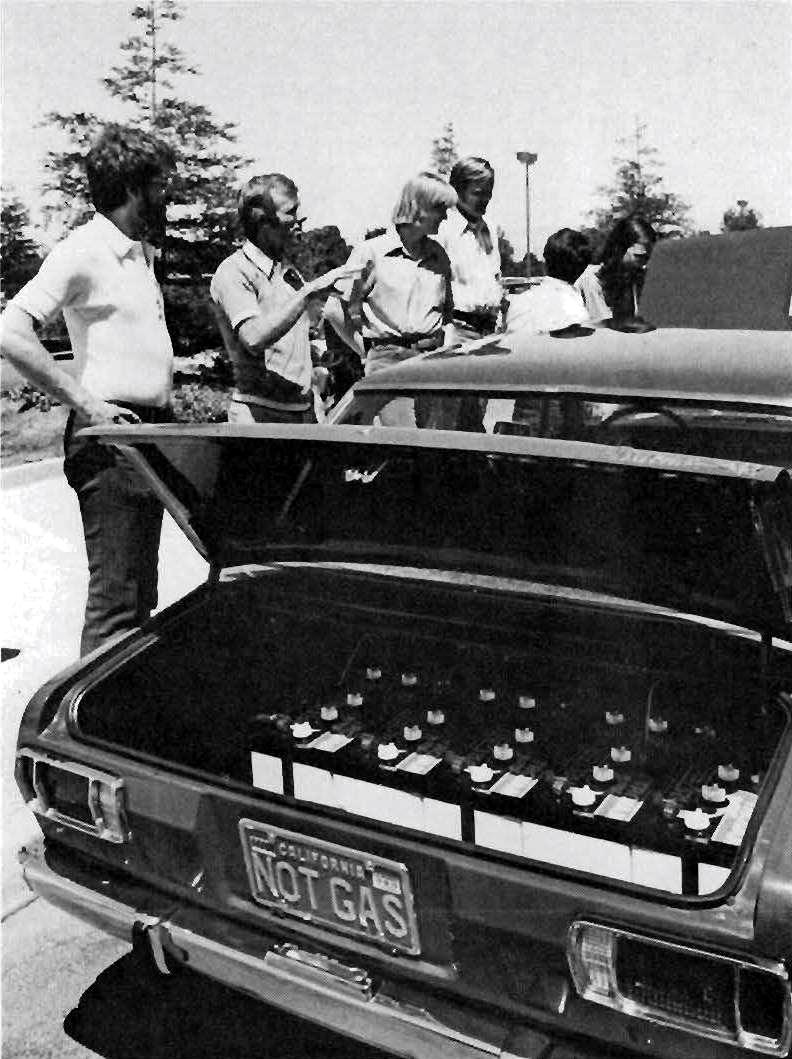Converted in 1978, this Datsun 1200 with 12,435 miles since conversion (now at 64,000+) is a unique, early example of a converted electric vehicle. The workmanship is impressive along with the history of the car participating in various events. This Datsun was also featured in the 1979 October issue of Popular Mechanics along with other publications in the Bay Area.
Contents |
Overview

MEDIA:
- Hewlett-Packard Measure magazine "We are driven - electrically!" (July, 1978) p. 13
- Popular Mechanics magazine (October, 1979) p. 97
- San Jose Mercury News (August 20, 1980)
- Noon Day / KGSA, Channel 36, San Jose (9-3-80)
- Evening Magazine / KPIX, Channel 5, S.F. (11-10-80)
- PM Magazine / National Television (1-7-81)
- Inducted into Towe Ford Museum (4-9-89)
AWARDS:
- Best Looking - 1978 Annual Electric Car Rally
- Most Practical - 1980 East Bay EAA Rally

CONVERSION COST: $1,871

CONTROLLER: Curtis/PMC (Model 21) rated for Armature control of 84V/450A. IC Transistor (Pulse Width Modulated) with built-in current limiting, overload protection, free-wheeling diode, and temperature sensing.
CURB WEIGHT: 1587 lbs. as Gasoline Powered, 2322 as Electric.
TRANSMISSION: Standard original equipment (four speed with reverse). Adapter Plate and coupling by John Wasylina.
TIRES: Bridgestone 155SR12 (Whitewall Steel Belted Radials).
Measure Magazine
Hewlett-Packard Measure magazine "We are driven - electrically!" July, 1978 p. 13

We are driven -- electrically!
Borrowing the words from a current advertising slogan, you might say nobody demands more from a Datsun than -- well, than HP's Bill Williams. Bill, a systems programmer at GSD, has just finished converting his 1972 model to run on store electricity rather than gasoline -- a project started in late 1976. And if you ask him why he was willing to put 1152 man-hours of his own energy into producing an energy-efficient car, the answer you get is simple: "I was frustrated with the price of gasoline."
It's not that the car was a bummer before. "I was getting outstanding gas mileage with it," Bill says. "In fact I was reluctant to tear a good car apart."
Still, the idea had been in the back of his mind since the gas crunch of 1974, when he began looking around for a better way of commuting. The obvious alternative vehicle, the bicycle, was not for him. "I broke my leg in a motorcycle accident in 1955," he explains, "so I was a little afraid of being exposed like that."
Bill notice that the U.S. Postal Service was using some small electric vans. He enquired about them, and a helpful postal employee in Cupertino directed him to the Electric Auto Association. Through that organization he learned that he was not alone in what he was contemplating. "I found out that the technology existed and people had done it," he says. A whole world of electric car buffs -- amateur automobile enineers, mechanics, weekend scientists and energy-concious commuters like himself -- was suddenly opened up to him.
The clincher came when the car blew a head gasket. Faced with $700 worth of repairs to the damaged engine, Bill reasoned that for a little more than that he could replace it with an electric system. (His final out-of-pocket expenses were over $1200, but he's recouping some of that by selling parts from the gasoline engine.)
Bill joing the Electric Auto Association and began swapping ideas with other members. None of the designs he looked at seemed suitable for his own project. ("Everybody does it his own way, and there were things I didn't like about most of the ones I saw.") But he began working with a retired engineer who was building a system, and when they had refined and tested it thoroughly, Bill began a similar one for his own car.
The motor is a 30-horsepower starter-generator. Top speed is 35 to 45 miles per hour, not likely to win any races. It's powered by 6-volt batteries which give it a range of 25 miles before recharging -- plenty adequate for Bill's 12-mile daily commute to and from the new General Systems Division building on the Cupertino site. The controller for the system is a privately made kit. "I also designed the system to be adaptable whenever a better battery is made," says Bill, "or if something like solar power becomes practical."
The brakes and the rest of the drive train -- clutch, transmission and drive shaft -- are the original equipment. Bill also took the opportunity to painstakingly restore the automobile to like-new condition, so it now looks more like a "show" car than a commuting workhorse.
Bill is also working toward energy independence in other ways. He installed a solar heat system for his swimming pool, and he's investigating windmiill power for some of his other energy needs. In those technologies, too, the serious amateurs seem to be leading the way in coming up with practical day-to-day application. And, like and good product designer -- amateur or professional -- Bill is already thinking about this "second generation" electric car.
1979

Popular Mechanics magazine, October 1979

Charging connection is at old tank fill.
Eight of the 12 batteries are in the trunk.

2016
POST For Sale blue Datsun 1200 sedan electric power Sacramento, California USA
Exterior
This car's never waited on a gasoline line!





License number plate 'NOT GAS' issued by CALIFORNIA














Interior
Six batteries are in passenger compartment rear floor















1986 14th Annual SCEAA Electric Car Rally 1987 15th Annual SCEAA Electric Car Rally
Solar Car Project Stanford University Centennial Electric Vehicle Rally May 16, 1987
Hobbs hour meter, Stewart Warner instruments

Engine Compartment
Designer Plaque: Bill Williams, 7 May 1978


Engine compartment holds electric motor and controller.





![[Datsun 1200 encyclopedia]](/wiki/upload/wiki.png)














